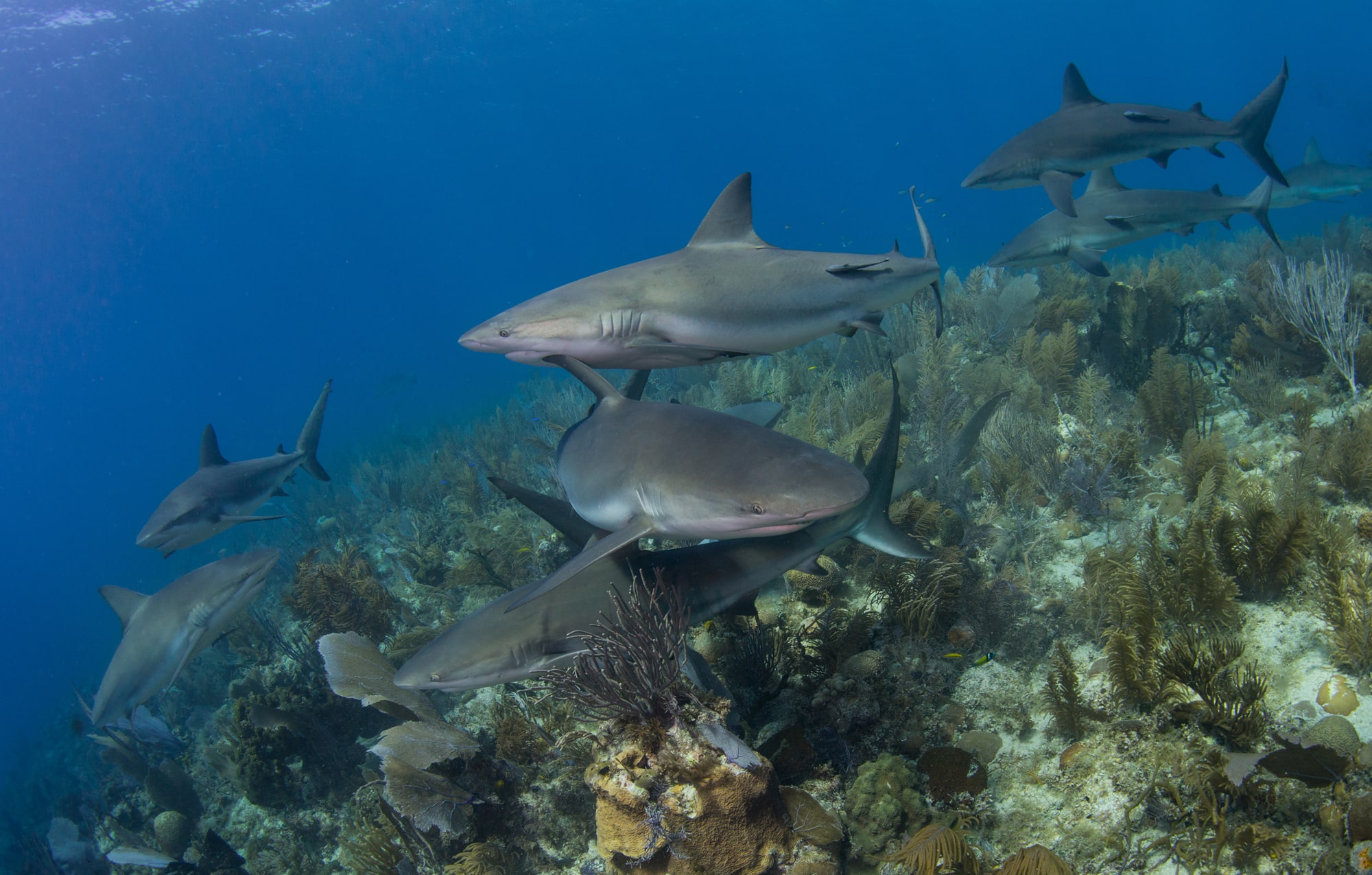Marine Life & Conservation
Diving the Indian Ocean Reefs
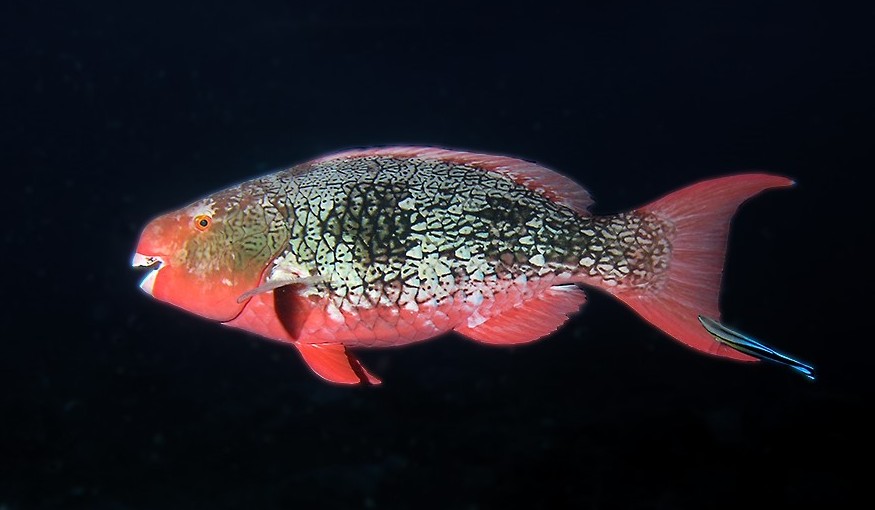
Parrot Fish… Did You Know?
The most colourful fish you’ll notice at on your first Indian Ocean dive may well be the spectacular turquoise-green, blue and pink male Ember Parrot Fish, (Scarus Riboviolaceus) which is by far the most common of the parrot fishes seen on our Indian Ocean reefs.

Male Ember Parrot fish
The males are gorgeous, and completely different from the juveniles and females.
Parrot fishes start life in the hard stag-horn corals and branching finger corals as insignificant little striped fish. The juvenile and semi-juvenile just look like any other small striped fish, with only the distinctive beak-like mouth to distinguish them from any other very young fish species.
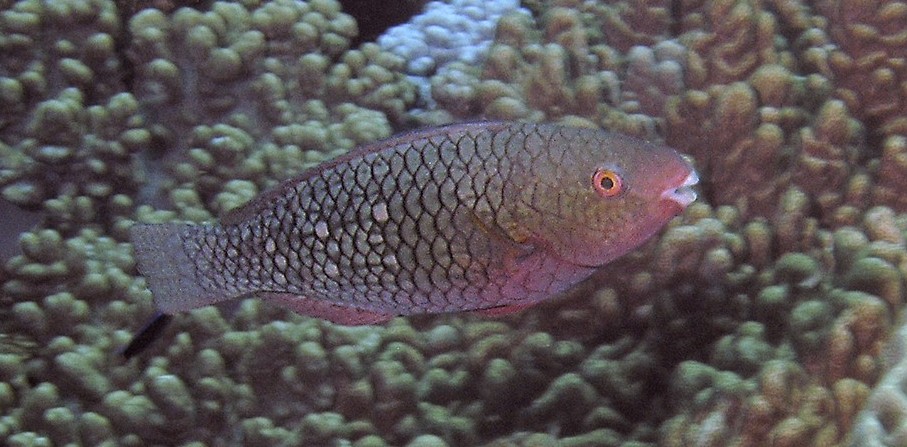
Semi-Juvenile Ember Parrot Fish
They grow into nondescript rust grey and brown females who inconspicuously cruise across the reef crunching on the hard corals. As young fish they travel in groups, but as they get older and bigger, they feed alone.

Juvenile Ember Parrot Fish
As they grow their colouring develops, and they become more spectacular, with bigger bodies, richer fin outlines and the drab brown begins to bloom with new colour. There can only be one male in any area. One day, when the dominant male in an area dies, the largest female loses her mind and her drab colouring and turns into a peacock-coloured randy male who chases the drab brown females across the reef, mating indiscriminately.
As the male reaches terminal stage, his colouring begins to fade and he dies. We have seen huge terminal male Ember Parrot Fish in the sea-grass beds South of Stringer Reef at Sodwana Bay.

On the shallower reefs, you may be lucky enough to see the rare and beautiful Bridle Parrot (Scarus Frenatus) fish, and if you look carefully at the markings, you may be able to distinguish a Tricolour Parrot ( Scarus Tricolor) fish from a Christmas or Starry-Eyed (Calotomus carolinus) parrot fish, or spot an occasional Blue Moon Parrot ( Chlorurus Atrirunula) fish.
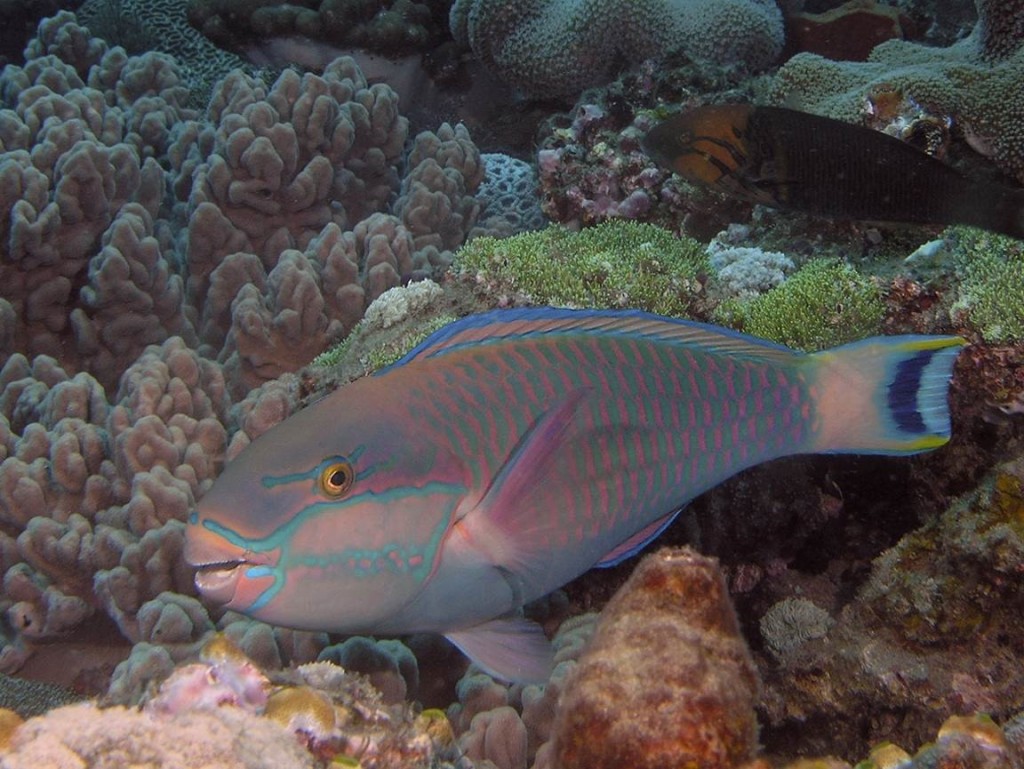
We have seen Blue Barred Parrot ( Scarus Ghobban) fish, and in deeper water, around and occasionally on the staghorn corals on the edge of 2 Mile Sodwana Bay, you might be lucky enough to see the richly coloured dark blue velvet of a female Hump Head Parrot ( Chlorurus Cyanascens) fish, or the ornate green and blue of the male Hump Head.
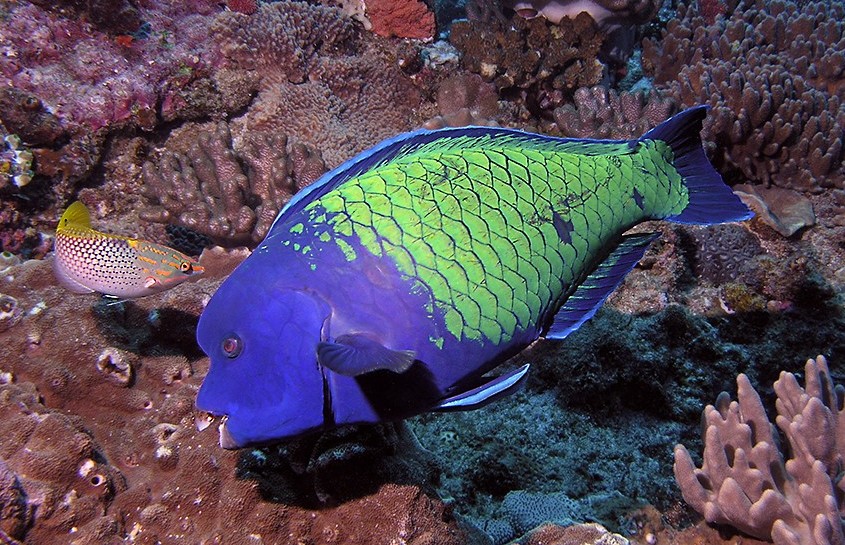
The Parrot fish family lives on the polyps and algae that make up the hard corals, and they graze continually. Living on hard corals is enormously time consuming, as the nutritious part of the polyp is minute. The parrot fishes are at least partly responsible for containing the growth of finger corals and branching corals.
They excrete a fine white powder which in part makes up most of the world’s powder white coral sand beaches – bio-sand production perhaps?
In Mauritius parrot fish are a delicacy, and the result has been a massive depletion in the variety of species near the main Island.
Under-age sex is the norm among the parrot fish here, with very juvenile females taking on the male role when they are too young. They are breeding a dwarf ember parrot fish, which has become quite prolific as it is too small to eat. I have often seen 8 inch little ember males haring after distinctly under-age females with lustful eyes.
On the outer Islands, the parrot fishes grow to normal size, as the subsistence fishermen cannot take their little boats out to the distant Islands. As the numbers of subsistence fishermen drops with the increase of wealth among the Mauritian population on the Island, perhaps we’ll see the exquisite parrot fish replaced on local menus by chicken.
[hr style=”single”]
Words Jill Holloway
Pics David Holloway
Copyright Ocean Spirit
Marine Life & Conservation
Double Bubble for Basking Sharks

 The Shark Trust is excited to announce that, for two more days only, all donations, large or small, will be doubled in the Big Give Green Match Fund!
The Shark Trust is excited to announce that, for two more days only, all donations, large or small, will be doubled in the Big Give Green Match Fund!
Donate to Basking in Nature: Sighting Giants
The Shark Trust is hoping to raise £10k which will be doubled to £20k. This will go towards Basking in Nature: Sighting Giants. And they need YOUR help to reach they’re goal.
The Shark Trust’s citizen science project is to monitor and assess basking sharks through sightings; encouraging data collection, community engagement, and promoting nature accessibility. This initiative aims to enhance health and wellbeing by fostering a deeper connection with British Sharks.
Campaign Aims
- Increase citizen science reporting of Basking Sharks and other shark sightings to help inform shark and ray conservation.
- Provide educational talks about the diverse range of sharks and rays in British waters and accessible identification guides!
- Create engaging and fun information panels on how to ID the amazing sharks and rays we have on our doorstep! These can be used on coastal paths around the Southwest. With activities and information on how you can make a difference for sharks and rays!
- Promote mental wellbeing through increasing time in nature and discovering the wonders beneath the waves!
Donate, and double your impact. Click Here
Marine Life & Conservation
Leading UK-based shark conservation charity, the Shark Trust, is delighted to announce tour operator Diverse Travel as a Corporate Patron
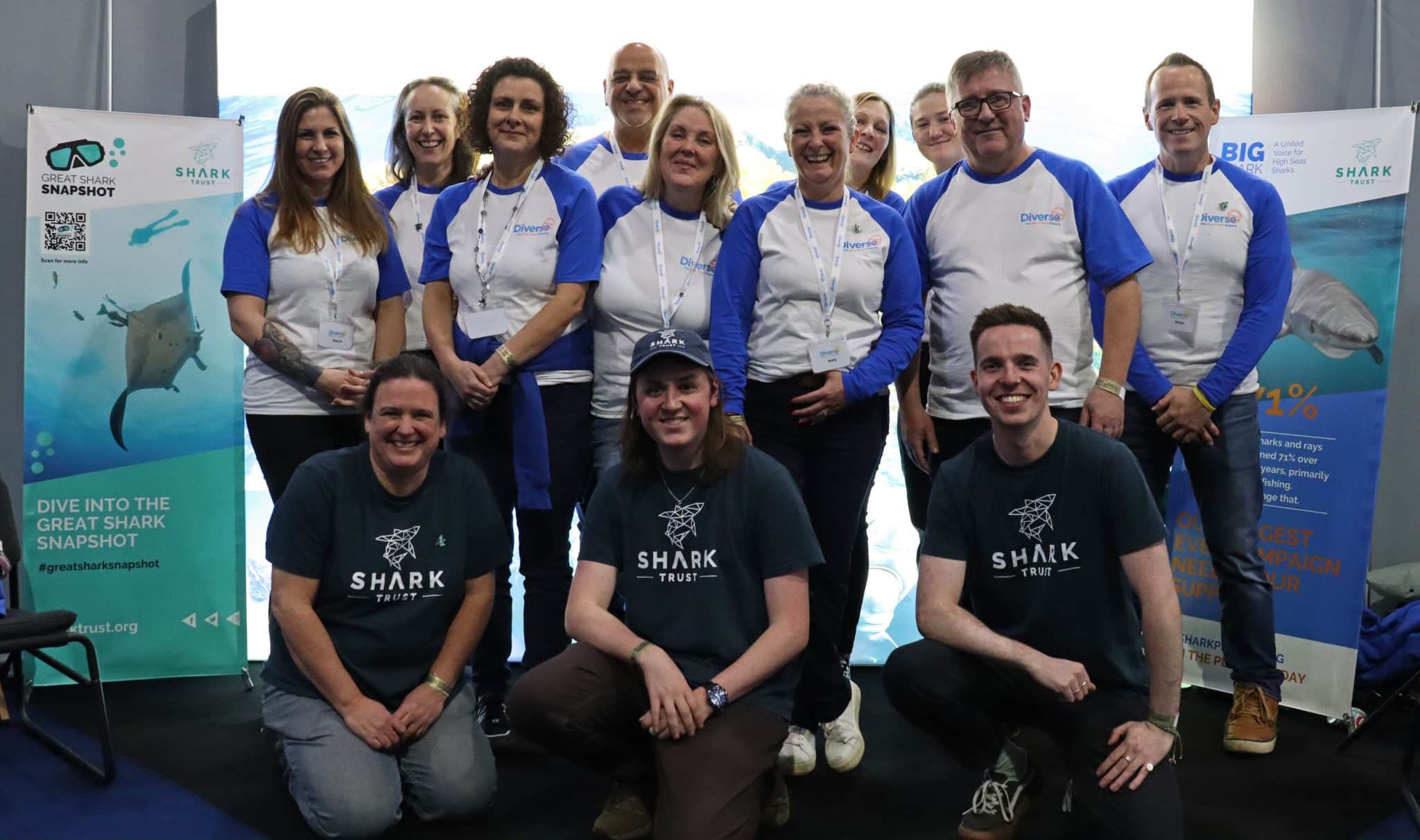
 Corporate Patrons provide a valuable boost to the work of The Shark Trust. The Trust team works globally to safeguard the future of sharks, and their close cousins, the skates and rays, engaging with a global network of scientists, policymakers, conservation professionals, businesses and supporters to further shark conservation.
Corporate Patrons provide a valuable boost to the work of The Shark Trust. The Trust team works globally to safeguard the future of sharks, and their close cousins, the skates and rays, engaging with a global network of scientists, policymakers, conservation professionals, businesses and supporters to further shark conservation.
Specialist tour operator Diverse Travel has operated since 2014 and is committed to offering its guests high quality, sustainable scuba diving holidays worldwide. Working together with the Shark Trust will enable both organisations to widen engagement and encourage divers and snorkellers to actively get involved in shark conservation.
“Sharks are truly at the heart of every diver and at Diverse Travel, we absolutely share that passion. There is nothing like seeing a shark in the wild – it’s a moment that stays with you forever!” says Holly Bredin, Sales & Marketing Manager, Diverse Travel.
“We’re delighted to celebrate our 10th year of business by becoming a Corporate Patron of the Shark Trust. This is an exciting partnership for Diverse and our guests. We will be donating on behalf of every person who books a holiday with us to contribute towards their vital shark conservation initiatives around the world. We will also be working together with the Trust to inspire divers, snorkellers and other travellers to take an active role – at home and abroad – in citizen science projects and other activities.”
Paul Cox, CEO of The Shark Trust, said:
“It’s an exciting partnership and we’re thrilled to be working with Diverse Travel to enable more divers and travellers to get involved with sharks and shark conservation. Sharks face considerable conservation challenges but, through collaboration and collective action, we can secure a brighter future for sharks and their ocean home. This new partnership takes us one more valuable step towards that goal.”
For more information about the Shark Trust visit their website here.
For more about Diverse Travel click here.
-

 News3 months ago
News3 months agoHone your underwater photography skills with Alphamarine Photography at Red Sea Diving Safari in March
-

 News3 months ago
News3 months agoCapturing Critters in Lembeh Underwater Photography Workshop 2024: Event Roundup
-

 Marine Life & Conservation Blogs2 months ago
Marine Life & Conservation Blogs2 months agoCreature Feature: Swell Sharks
-

 Blogs2 months ago
Blogs2 months agoMurex Resorts: Passport to Paradise!
-

 Blogs2 months ago
Blogs2 months agoDiver Discovering Whale Skeletons Beneath Ice Judged World’s Best Underwater Photograph
-

 Marine Life & Conservation2 months ago
Marine Life & Conservation2 months agoSave the Manatee Club launches brand new webcams at Silver Springs State Park, Florida
-

 Gear Reviews3 months ago
Gear Reviews3 months agoGear Review: Oceanic+ Dive Housing for iPhone
-

 Gear Reviews2 weeks ago
Gear Reviews2 weeks agoGEAR REVIEW – Revolutionising Diving Comfort: The Sharkskin T2 Chillproof Suit




